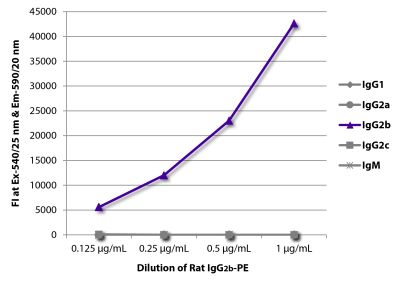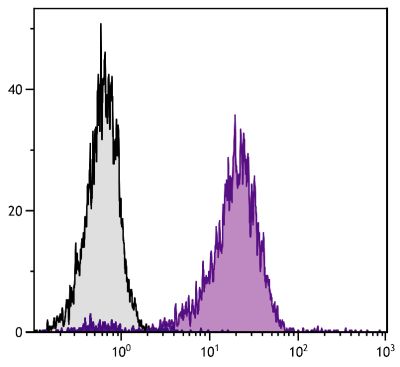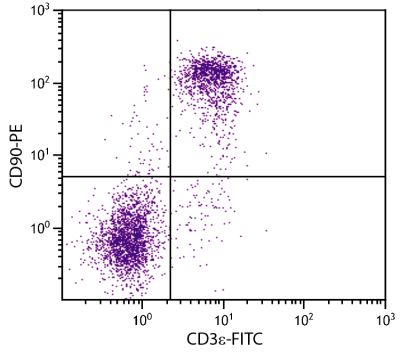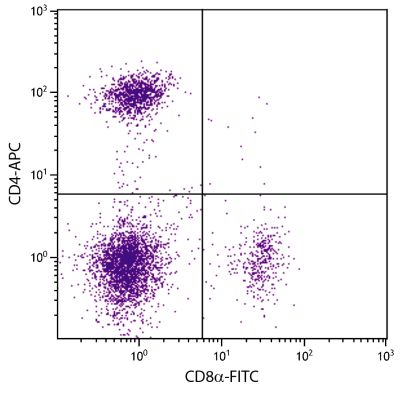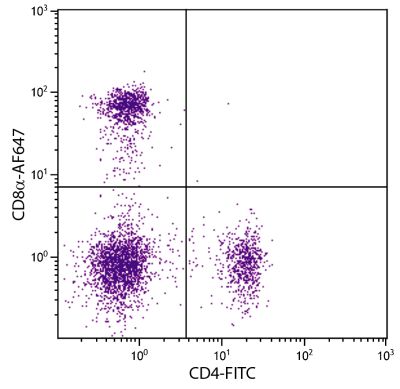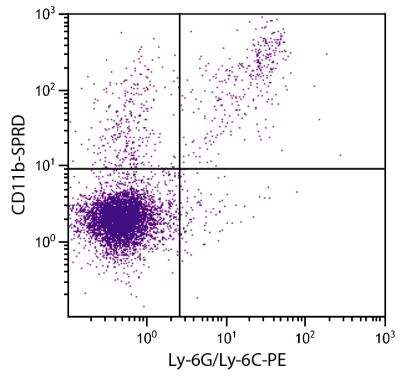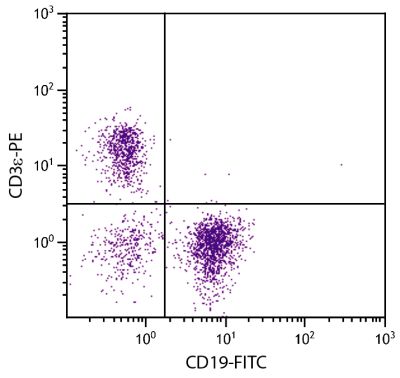Rat Anti-Mouse CD3ε-PE (C363.29B)
Only %1 left
Cat. No.:
1535-09L,
1535-09
PE Anti-Mouse CD3 epsilon antibody for use in flow cytometry assays.
As low as
$116.00
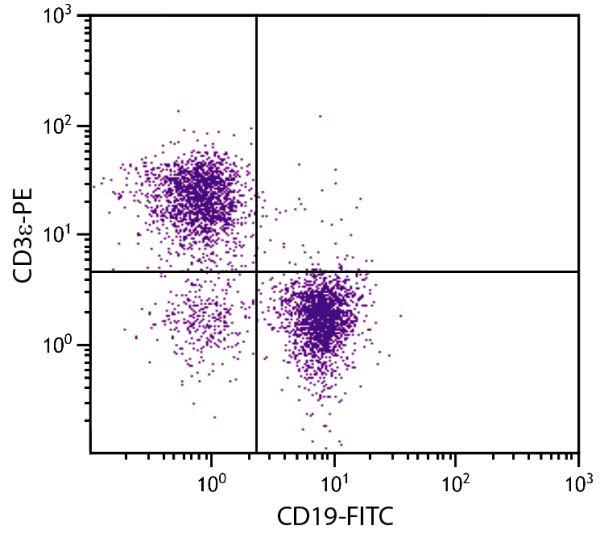

| Clone | C363.29B |
|---|---|
| Isotype | Rat (Lewis) IgG2bκ |
| Isotype Control | Rat IgG2b-PE (KLH/G2b-1-2) |
| Specificity | Mouse CD3ε |
| Alternative Names | CD3 epsilon |
| Description | CD3ε, a member of the immunoglobulin superfamily of cell surface receptors, is comprised of five invariable chain ranging in size from 16-28 kDa and is closely associated with the T cell antigen receptor (TCR). It is expressed on all T cells of all mouse strains. CD3 plays a major role in signaling during antigen recognition, leading to T-cell activation. The monoclonal antibody C363.29B recognizes an epitope on the 25 kDa ε chain of the CD3/TCR complex. In the presence of Fc receptor-bearing accessory cells, soluble C363.29B can activate primed and naïve T cell in vitro. Immobilized C363.2B9 monoclonal antibody can also activate both normal T lymphocytes and cloned T cell lines provided the appropriate accessory signals are present. The monoclonal antibody is cytolytic, easily used for cell surface staining, and a good immunoprecipitating antibody. |
| Immunogen | IL-4 producing Th2 cell lines including D10 |
| Conjugate | PE (R-phycoerythrin) |
| Buffer Formulation | Phosphate buffered saline containing < 0.1% sodium azide and a stabilizer |
| Clonality | Monoclonal |
| Concentration | 0.1 mg/mL |
| Volume | 1.0 mL or 2.0 mL |
| Recommended Storage | 2-8°C; Avoid exposure to light; Do not freeze |
| Applications |
Flow Cytometry – Quality tested 1,7-12 Immunohistochemistry-Frozen Sections – Reported in literature 2-4 Immunohistochemistry-Paraffin Sections – Reported in literature 5,6 Immunoprecipitation – Reported in literature 1 Depletion – Reported in literature 1 Activation – Reported in literature 1,4 Complement Mediated Cell Depletion – Reported in literature 1 |
| RRID Number | AB_2794822 |
| Gene ID |
12501 (Mouse) |
| Gene ID Symbol |
Cd3e (Mouse) |
| Gene ID Aliases | AI504783; CD3; CD3epsilon; T3e |
| UniProt ID |
P22646 (Mouse |
| UniProt Name |
CD3E_MOUSE (Mouse) |
Documentation
Certificate of Analysis Lookup
Enter the Catalog Number and Lot Number for the Certificate of Analysis you wish to view
- 1. Portoles P, Rojo J, Golby A, Bonneville M, Gromkowski S, Greenbaum K, et al. Monoclonal antibodies to murine CD3ε define distinct epitopes one of which may interact with CD4 during T cell activation. J Immunol. 1989;142:4169-75. (Immunogen, FC, IP, Depletion, Activ, CMDC)
- 2. Stanic AK, Stein CM, Morgan AC, Fazio S, Linton MF, Wakeland EK, et al. Immune dysregulation accelerates atherosclerosis and modulates plaque composition in systemic lupus erythematosus. Proc Natl Acad Sci USA. 2006;103:7018-23. (IHS-FS)
- 3. Ubogu EE, Yosef N, Xia RH, Sheikh KA. Behavioral, electrophysiological, and histopathological characterization of a severe murine chronic demyelinating polyneuritis model. J Peripher Nerv Syst. 2012;17:53-61. (IHC-FS)
- 4. Klingenberg R, Gerdes N, Badeau RM, Gisterå A, Strodhoff D, Ketelhuth DF, et al. Depletion of FOXP3+ regulatory T cells promotes hypercholesterolemia and atherosclerosis. J Clin Invest. 2013;123:1323-34. (Activ, IHC-FS)
- 5. Whiteland JL, Nicholls SM, Shimeld C, Easty DL, Williams NA, Hill TJ. Immunohistochemical detection of T-cell subsets and other leukocytes in paraffin-embedded rat and mouse tissues with monoclonal antibodies. J Histochem Cytochem. 1995;43:313-20. (IHC-PS)
- 6. Chen L, Lin S, Amin S, Overbergh L, Maggiolino G, Chan LS. VCAM-1 blockade delays disease onset, reduces disease severity and inflammatory cells in an atopic dermatitis model. Immunol Cell Biol. 2010;88:334-42. (IHC-PS)
- 7. Katayama Y, Hidalgo A, Peired A, Frenette PS. Integrin α4β7% and its counterreceptor MAdCAM-1 contribute to hematopoietic progenitor recruitment into bone marrow following transplantation. Blood. 2004;104:2020-26. (FC)
- 8. Avagyan S, Glouchkova L, Choi J, Snoeck H. A quantitative trait locus on chromosome 4 affects cycling of hematopoietic stem and progenitor cells through regulation of TGF-β2 responsiveness. J Immunol. 2008;181:5904-11. (FC)
- 9. Olah M, Ping G, De Haas AH, Brouwer N, Meerlo P, van der Zee EA, et al. Enhanced hippocampal neurogenesis in the absence of microglia T cell interaction and microglia activation in the murine running wheel model. Glia. 2009;57:1046-61. (FC)
- 10. Safari D, Dekker HA, Rijkers G, Snippe H. Codelivery of adjuvants at the primary immunization site is essential for evoking a robust immune response to neoglycoconjugates. Vaccine. 2011;29:849-54. (FC)
- 11. He X, Nair A, Mekasha S, Alroy J, O'Connell CM, Ingalls RR. Enhanced virulence of Chlamydia muridarum respiratory infections in the absence of TLR2 activation. PLoS One. 2011;6(6):e20846. (FC)
- 12. Grødeland G, Mjaaland S, Tunheim G, Fredriksen AB, Bogen B. The specificity of targeted vaccines for APC surface molecules influences the immune response phenotype. PLoS One. 2013;8(11):e80008. (FC)
See All References


